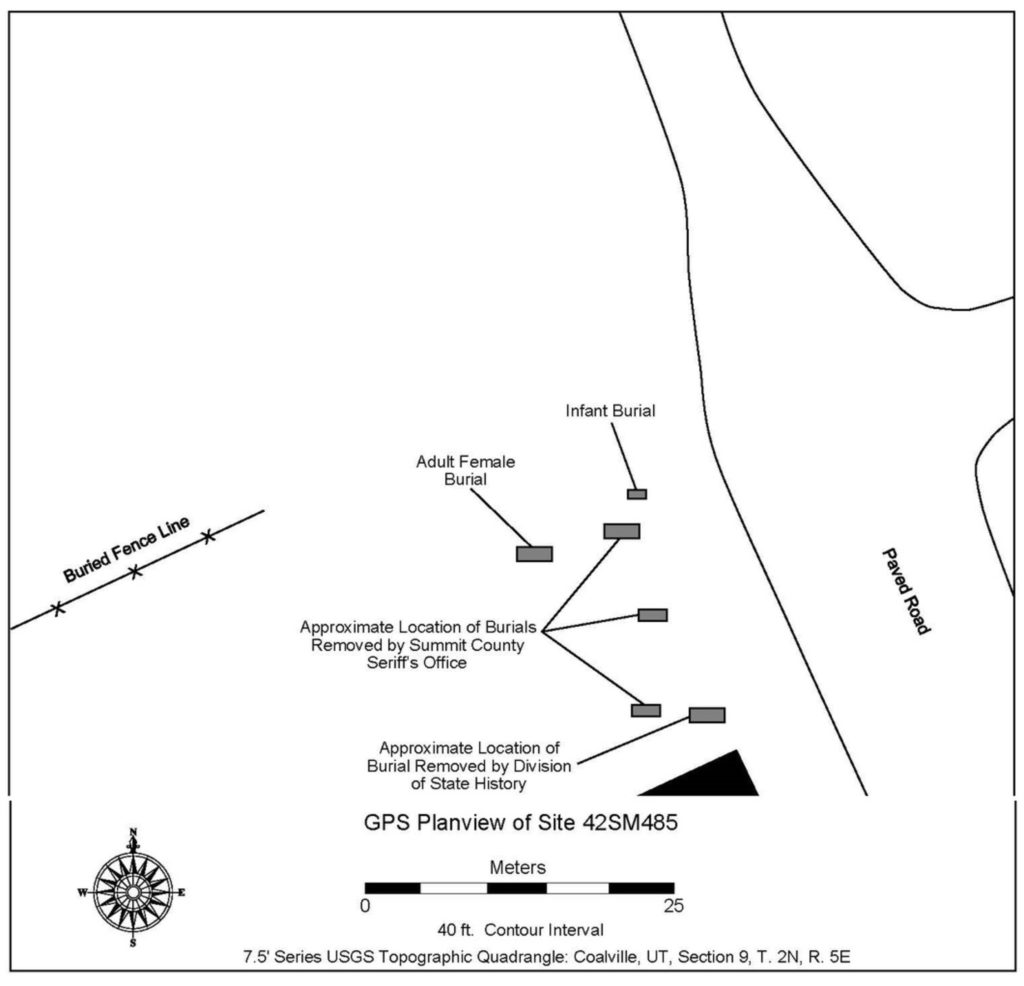by Jon Baxter, Bighorn Archaeological Consultants

Under our feet there are more than wooden stave pipes and mysterious bridges, sometimes we discover the echoes of lives long before today. (Editor’s note: we will not show images of human remains out of respect for the dead and their descendants.)
Big D Construction made a startling discovery in 2004 when they encountered something unexpected during a project. Over the course of several days, a total of six burials were encountered by construction workers. Fortunately, Big D Construction knew what to do and they stopped work in the area while they contacted Utah Office of the Medical Examiner and Summit County Sheriff’s Office. Once it was determined that these burials were archaeological and not recent, Bighorn Archaeological Consultants (Bighorn) was called in to quickly and respectfully excavate.
During the excavation, archaeologists worked carefully to remove the deceased using trowels, brushes, dental picks, and finally sifting screens. After the remains were photographed in place, archaeologists carefully removed them and sent them to the Utah Office of the Medical Examiner for analysis. Jane Hoff, an anthropologist consulting with the Office of the Medical Examiner, filed a report containing all the facts and information regarding the remains of the two individuals Bighorn recovered from the excavation.
Who Were These People?
In 1867, the citizens of Chalk Creek in Summit County incorporated their town and named it Coalville referencing the local coal mines. As houses and public buildings have expanded over the landscape, history has been unearthed and provides an insightful story about early pioneers. Although their names are unknown, it is through the careful study of the remains that archaeologists can learn a lot about what their lives were like during this time.
Anthropological analysis of the first four burials indicated that the individuals buried were a male aged 50+ years at death, a probable female aged 10-13 years at death and two infants aged 9-12 months and 12-18 months at death.

One burial was of an infant baby which had been wrapped or covered with cloth, possibly a blanket. The coffin was small, rectangular in shape, and probably made of pine or cedar. Numerous rusted, square-cut nails were found at the ends of the coffin suggesting a burial occurred before 1900 A.D. The anthropological analysis of the infant’s teeth suggested they had died between birth and six months of age – a tragic but all too common fate for many young children of the time.

The second burial told a different story as it was the remains of an adult Anglo female in a coffin made of pine or cedar. Only one rusted nail was recovered, a square nail indicating a pre-1900 burial with some coffin hardware also found.
A majority of the bones from the female Anglo body were found in good condition. The anthropologist analyzing the remains noted the individual was likely a 5’ 3” tall adult in her mid-twenties. Although the bones did say she had arthritis, there were no signs of chronic diseases, suggesting years of hard labor even at her young age.
A large amount of hair was present, and it was arranged in long coils, which were united at the back of the head and tied with a small amount of twine into a bun. The blonde or light brown hair was long, silky, moderately fine and straight. At the time of her death, evidence shows she was cared for as someone took the time to braid her long, blond hair and tie it with twine.

The detailed anthropological report also noted her teeth were in poor condition with two cavities on her lower jaw and also five teeth missing before she died. She also had an overbite, significant tartar build up, and even a gap in her front teeth. The anthropologist noted this is frequently a family trait. These details highlight the poor dental hygiene in the late 19th century Utah.
This woman was likely well-dressed when she was buried. Although the fabric had completely decomposed, two buttons were found, one located on her chest and one by her left hand. The buttons themselves tell a marvelous story. Her one white, porcelain button had purple stars painted on it, making them “Calico” style buttons. These buttons were luxury items, first made in England and after 1848, in Greenpoint, Long Island. She appeared to be finely dressed in clothing that boasted imported details.
Coalville Reacts
Since those early days Coalville’s population has grown to 1,797 (2019 census), but residents are deeply connected to their past. These burials were discovered at the site of the (then) future high school, and high school students volunteered to build coffins for each of the individuals. The remains of each person were laid to rest in these new coffins. Although their names were not known, each had a plaque identifying them.


If time would allow, we could talk more of the history of Coalville and the parts these individuals may have played in the building of the town. But for now, we know they were hard working adults and young children who were brave and courageous out in the frontier and died too early due to the hard world they lived in. On January 13, 2005, the residents of Coalville placed these early residents into the City Cemetery so their lives would be remembered.
May we respect them, their accomplishments, and learn from their stories.

